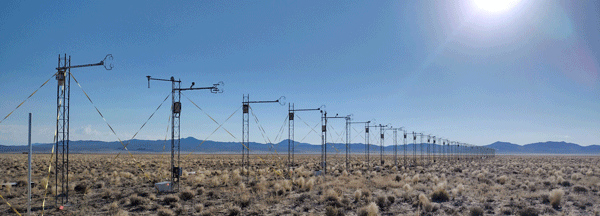Welcome to the ERTH 420, Earth System Science, public webpage for the Spring 2024 semester.
I will try to update this page every few days during the semester.

An array of 50 sonic anemometers spaced 5 m apart to study the structure of turbulence in the atmospheric surface layer. Photo by S. D. Mayor.
Spring 2024 Lectures: MWF, 10:00 - 10:50 PM.
Required book: The Earth System 4th edition by James Kasting, Lee Kump, and Robert Crane.
Mon. 22 Jan., Faculty on Strike. No Classes
Weds., 24 Jan., First day of the semester. Review syllabus and begin Chapter 15: Pleistocene glaciation
Fri., 26 Jan., Continue Chapter 15: causes of the 100,000 year glacial/interglacial cycle: Milankovitch theory
Mon., 29 Jan., review Milankovitch theory, discuss Fourier analysis, vocabulary for systems approach
Weds., 31 Jan., Weather versus climate, introduction to systems, fast and slow, internal and external forcings and perturbations
Fri., 2 Feb., Types of models, then all of Chapter 2: Daisyworld, Intro to Systems.
Mon., 5 Feb., Students gathered into groups, discussed specific feedbacks, and presented to class.
Weds., 7 Feb., Quiz #1 today. In lecture: The nature of electromagnetic radiation (wave-particle duality) and inverse square law. Introduce blackbody radiation.
Fri., 9 Feb., Special guest lecture in Physics Dept on Atmospheric turbulence recorded.
Fri., 9 Feb., Last day to add or drop classes without special permission of instructor.
Mon., 12 Feb., Board work on global energy balance: planet with no atmosphere versus 1-layer opaque atmosphere, and solving the easiest ODEs.
Weds., 14 Feb., Quiz #2 today. In lecture: creating Planck functions in Matlab.
Fri., 16 Feb., Last day to drop with instructor's permission.
Fri., 16 Feb., Selective absorbers, wavenumber, HIRTRAN, MODTRAN, absorption cross sections, Beer-Bouguer-Lambert Law.
Mon., 19 Feb., Board work: derivation of the hydrostatic equation and barometric law.
Weds., 21 Feb., Mean vertical structure of the atmosphere. Energy transfer methods including latent heating and cooling due to condensation and evaporation.
Fri., 23 Feb., The role of clouds in Earth's climate, Global energy budget, radiative forcing, cloud feedback.
Mon., 26 Feb., Board work: derivation of exponential growth function from differential equation. Discussion of finite difference methods.
Weds., 28 Feb., Matlab examples of modeling exponential growth (analytic versus a crude finite difference method).
Fri., 1 Mar., Types of climate models: RCMs vs GCMs. Model parameterizations.
Mon., 4 Mar., Exam #1 on everything so far. No lecture today.
Weds., 6 Mar., Matlab instruction on linear interpolation to assist with Matlab assignment #3.
Fri., 8 Mar., Begin Chapter 4: The Atmospheric Circulation. Derivation of ideal gas law. How and why buoyancy and convection occur.
Mon., 11 Mar., Review of Matlab assignment #4, and then answer questions about wind.
Weds., 13 Mar., What makes the horizontal wind blow: Pressure gradient forces, Coriolis "force", and geostrophic wind
Fri., 15 Mar., Discussion of Matlab assignment and then discussion of the vector form of equation of motion
Mon., 18 Mar., Spring break. No classes.
Weds., 20 Mar., Spring break. No classes.
Fri., 22 Mar., Spring break. No classes.
Mon., 25 Mar., Global atmospheric circulation: tropospheric polar vortex, Rossby waves, and 3-cell model
Weds., 27 Mar., The "Friction layer", and then a review of 3-cell model and changes in weather and climate with latitude
Fri., 29 Mar., Lecture on the fascinating dynamics of the stratosphere: annual flow reversal, SSWs, and the QBO
Mon., 1 Apr., César Chávez Day (observed). Campus closed.
Weds., 3 Apr., Lecture on the hydrologic cycle: the profound roles of water in the Earth system
Fri., 5 Apr., Guest speaker: Dr. Amy Butler from NOAA CSD on sudden stratospheric warmings
Mon., 8 Apr., 40 point test on Chapter 4. No lecture today.
Weds., 10 Apr., Begin Chapter 5 on Ocean Circulation. Facts about the oceans and waves. Begin Ekman spiral.
Fri., 12 Apr., Ekman spiral, Ekman transport, major ocean gyres, upwelling and downwelling.
Mon., 15 Apr., Coastal and equatorial upwelling. Then, boundary currents and asymmetry of the gyres: conservation of absolute vorticity.
Weds., 17 Apr., Walker circulation, El Niño and the Southern Oscillation (ENSO), also La Niña.
Fri., 19 Apr., Briefly teleconnections. Then salinity, temperature, and density to begin deep ocean circulation.
Mon., 22 Apr., Thermohaline circulation: Sandstrom's theorem, heat engines and heat pumps, global ocean conveyor.
Weds., 24 Apr., No in-person lecture because instructor here. Students work on essays about ocean circulation.
Fri., 26 Apr., Complete Chapter 5 on Oceans. Begin Chapter 6 on Cryosphere. Tribute to Koni Stefan.
Mon., 29 Apr., Continue with Cryosphere: comparison of Greenland and Antarctica. Ice sheet movement. Ice streams, ice shelves, ice bergs. Then, snow and ice cores.
Weds., 1 May, Quiz on Chapter 5 (Ocean circulation). Also short essay on ocean circulation due. No in-person class.
Fri., 3 May, Sea ice, flux-gradient relationships, bulk formula at atmosphere land/ocean/ice interface.
Mon., 6 May, Sea ice, katabatic flows, leads and Polynya, and alpine glaciers.
Weds., 8 May, Begin review: Summary of influences on climate (from large to small), and evidence of recent (within last 100 yrs) climate change.
Fri., 10 May, Conclude review: Influences on climate, and actions individuals can take to slow global warming.
Weds., May 15, Final comprehensive exam.
Dr. Mayor's page
